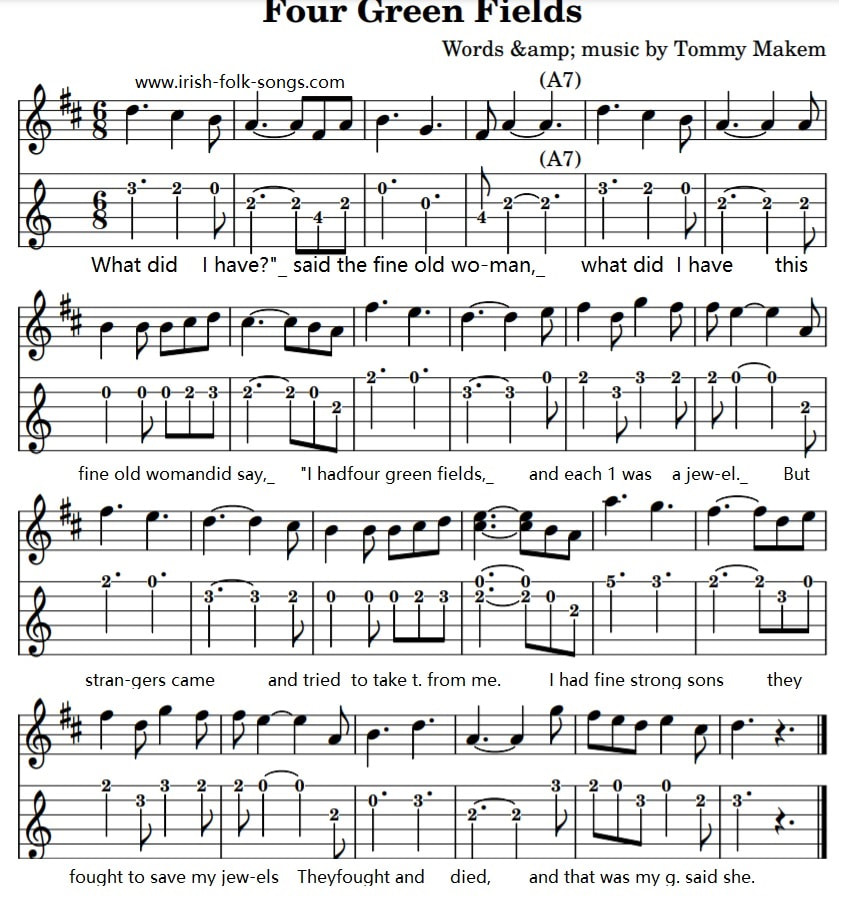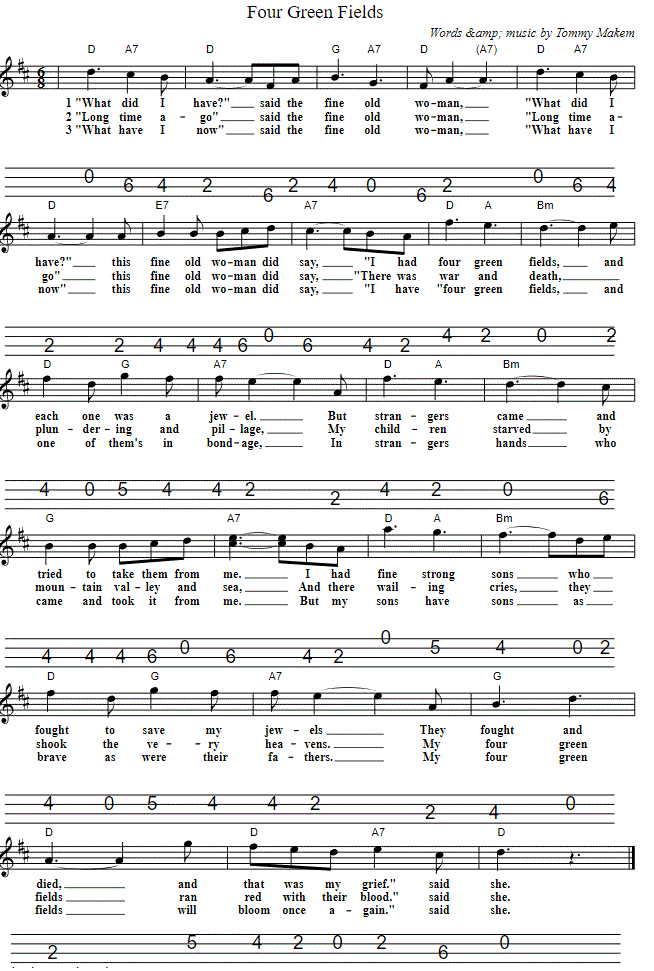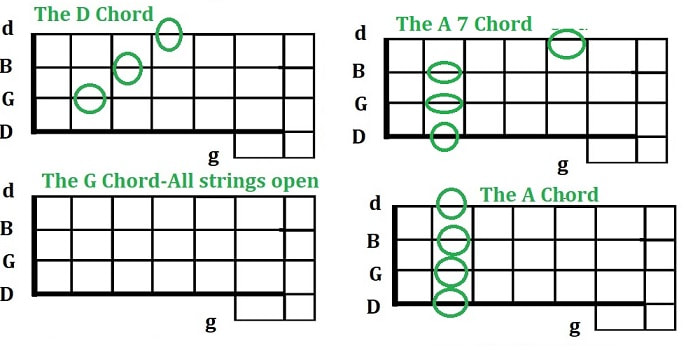Four Green Fields Lyrics And Chords
Written by Tommy Makem. The Clancy Four green fields guitar tab now added. 5 string banjo chords for the key of D Major are now here.This song is a parable of the British colonization of Ireland,The old woman in the song is Ireland And the four green fields are the provinces of Ulster Munster Connaught And Leinster. Written by Tommy Makem, an Irish rebel song. Four Green Fields Sheet Music .
|
[D]What[A7] did I[D] have said the[G] fine old wo[D]man,
[D]What[A7] did I[D] have,this[Em] fine old woman did [A7]say, I have[D] four[A7] Green[D] fields,each one[G] was a je[A]wel, But[D] stran[A]gers[D] came and[G] tried to take them from[A] me, I had[D] fine[A] strong[D] sons,they fought to[G] save my je[A]wels, They[G] fought and they[D] died,and that was my[A] greef said[D] she. [2] Long time ago said the fine old woman, Long time ago this fine old woman did say, There was war and death,plundering and pillage, My children starved,by mountain vally and streem, And their wailing cry,it shook the very heavens, My four Green fields ran red with their blood said she. [3] What have I now said the fine old woman What have I now this proud old woman did say, I have four Green fields,one of them's in bondage, In strangers hands,that tried to take them from me, But my sons have sons as brave as were their fathers, My four Green fields will bloom once again said she, My forth Green field will bloom once agai |
FOUR GREEN FIELDS Key Of C' 3/4
I got this version from Marc Fahrbach, It's good to have a few versions in different keys as every body's voice changes over the years, a song you may have played when you were 18 years old in the key of D' will have changed to the key of E by the time you reach 30, the voice deepens with age. You can easy change keys with the handy chord changer on the site. (C)'What (G)did I (C)have?' said the (F)fine old (C)woman, 'What (G)did I (C)have?' this (D)proud old woman did (G)say 'I had (C)four (G7)green (C)fields, each one (F)was a (G7)jewel, But (C)stran(G7)gers (C)came and (D7)tried to take them from (G7)me. I had (C)fine (G7)strong (C)sons they fought to (F)save my (G7)jewels, They (F)fought (G7)and they (C)died and that was my (G7)grief' said (C)she. (C)'Long (G)time a(C)go' said the (F)fine old (C)woman, 'Long (G)time a(C)go' this (D)proud old woman did (G)say, 'There was (C)war (G7)and (C)death, plunde(F)ring and (G7)pillage. My (C)chil(G7)dren (C)starved by (D7)mountain valley and (G7)sea, and their (C)wai(G7)ling (C)cries they reached the (F)very (G7)heavens. And my (F)four (G7)green (C)fields ran red with their (G7)blood' said (C)she. (C)'What (G)have I (C)now?' said the (F)fine old (C)woman, 'What (G)have I (C)now?' this (D)proud old woman did (G)say. 'I have (C)four (G7)green (C)fields, one of (F)them's in (G7)bondage, In (C)stran(G7)gers (C)hands who (D7)tried to take it from (G7)me. But my (C)sons (G7)they have (C)sons as brave as (F)were their (G7)fathers, And my (F)four (G7)green (C)fields will bloom once a(G7)gain' said (C)she. |
The version below of the guitar tab is in CGDA tuning.
The Irish song 'Four Green Fields', written by Tommy Makem, is a powerful and poignant reflection on the history of Ireland and its struggle for independence. The song tells the story of Ireland through the metaphor of four green fields, symbolizing the four provinces of Ireland – Ulster, Munster, Leinster, and Connacht. Through its lyrics, the song explores the themes of loss, resilience, and the enduring spirit of the Irish people.
The song begins with an image of a woman, who is referred to as 'the dark Rosaleen', standing in the midst of her four green fields. This woman represents Ireland, and the fields are a symbol of the land that has been torn apart by centuries of conflict and oppression. The use of the name Rosaleen, which means 'little rose', evokes a sense of tenderness and vulnerability, highlighting the delicate state of Ireland.
The first verse of the song focuses on Ulster, the northernmost province of Ireland. The lyrics describe how Ulster was once a land of beauty and abundance, with its 'green valleys' and 'rolling hills'. However, this idyllic land has been ravaged by war and its fields are now 'empty and bare'. This verse alludes to the historical conflicts that have plagued Ulster, including the Plantation of Ulster in the 1600s and the more recent Troubles in the late 20th century.
The second verse moves on to Munster, the southern province of Ireland. Munster is described as a 'land of great fame' and 'the home of O'Brien and O'Neill'. These were two of the most powerful Irish clans who fought against British rule in the 16th century. However, Munster has also suffered from the effects of colonization and its fields are now 'ploughed with sorrow'. This verse reflects on the loss of Irish culture and the struggles faced by its people.
Leinster, the eastern province of Ireland, is the focus of the third verse. This verse highlights how Leinster was once a land of 'brave warriors' and 'bright scholars'. However, it too has been subjected to invasion and oppression, and its fields are now 'barren and wasted'. This verse also references the Great Famine in the mid-19th century, which devastated the population and left the land desolate.
The final verse of the song centers on Connacht, the western province of Ireland. This verse acknowledges that Connacht has not been spared from the suffering of the other provinces, but it also celebrates the resilience of its people. Despite the hardships they have faced, the fields of Connacht are still 'green and fair'. This verse speaks to the enduring spirit of the Irish people, who have persevered through centuries of struggle.
The chorus of the song ties together the four provinces, stating that they are 'all part of our dear land'. This line emphasizes the unity of Ireland and the common history and struggles that bind its people together. It also serves as a call to action, urging the Irish people to unite and fight for their shared land.
One of the most notable aspects of 'Four Green Fields' is its use of symbolism. The four green fields represent not only the four provinces of Ireland but also the four stages of Irish history – prosperity, conflict, loss, and resilience. The use of a woman to represent Ireland also adds a layer of symbolism, with the female figure often being associated with the land and its fertility in Celtic mythology.
The song also has a strong political message, as it was written during a time of increased tension and violence in Northern Ireland. It was first performed in 1967, during the Troubles, and has since become an anthem for Irish nationalism and the fight for independence. The lyrics serve as a reminder of the struggles and sacrifices made by the Irish people in their quest for self-determination.
In conclusion, 'Four Green Fields' is a powerful and evocative song that captures the complex and tumultuous history of Ireland. Through its use of symbolism and powerful lyrics, the song conveys a sense of loss, resilience, and unity that is deeply rooted in Irish culture. It continues to be a source of inspiration and pride for the Irish people, reminding them of their past struggles and the ongoing fight for a united and independent Ireland.
The song begins with an image of a woman, who is referred to as 'the dark Rosaleen', standing in the midst of her four green fields. This woman represents Ireland, and the fields are a symbol of the land that has been torn apart by centuries of conflict and oppression. The use of the name Rosaleen, which means 'little rose', evokes a sense of tenderness and vulnerability, highlighting the delicate state of Ireland.
The first verse of the song focuses on Ulster, the northernmost province of Ireland. The lyrics describe how Ulster was once a land of beauty and abundance, with its 'green valleys' and 'rolling hills'. However, this idyllic land has been ravaged by war and its fields are now 'empty and bare'. This verse alludes to the historical conflicts that have plagued Ulster, including the Plantation of Ulster in the 1600s and the more recent Troubles in the late 20th century.
The second verse moves on to Munster, the southern province of Ireland. Munster is described as a 'land of great fame' and 'the home of O'Brien and O'Neill'. These were two of the most powerful Irish clans who fought against British rule in the 16th century. However, Munster has also suffered from the effects of colonization and its fields are now 'ploughed with sorrow'. This verse reflects on the loss of Irish culture and the struggles faced by its people.
Leinster, the eastern province of Ireland, is the focus of the third verse. This verse highlights how Leinster was once a land of 'brave warriors' and 'bright scholars'. However, it too has been subjected to invasion and oppression, and its fields are now 'barren and wasted'. This verse also references the Great Famine in the mid-19th century, which devastated the population and left the land desolate.
The final verse of the song centers on Connacht, the western province of Ireland. This verse acknowledges that Connacht has not been spared from the suffering of the other provinces, but it also celebrates the resilience of its people. Despite the hardships they have faced, the fields of Connacht are still 'green and fair'. This verse speaks to the enduring spirit of the Irish people, who have persevered through centuries of struggle.
The chorus of the song ties together the four provinces, stating that they are 'all part of our dear land'. This line emphasizes the unity of Ireland and the common history and struggles that bind its people together. It also serves as a call to action, urging the Irish people to unite and fight for their shared land.
One of the most notable aspects of 'Four Green Fields' is its use of symbolism. The four green fields represent not only the four provinces of Ireland but also the four stages of Irish history – prosperity, conflict, loss, and resilience. The use of a woman to represent Ireland also adds a layer of symbolism, with the female figure often being associated with the land and its fertility in Celtic mythology.
The song also has a strong political message, as it was written during a time of increased tension and violence in Northern Ireland. It was first performed in 1967, during the Troubles, and has since become an anthem for Irish nationalism and the fight for independence. The lyrics serve as a reminder of the struggles and sacrifices made by the Irish people in their quest for self-determination.
In conclusion, 'Four Green Fields' is a powerful and evocative song that captures the complex and tumultuous history of Ireland. Through its use of symbolism and powerful lyrics, the song conveys a sense of loss, resilience, and unity that is deeply rooted in Irish culture. It continues to be a source of inspiration and pride for the Irish people, reminding them of their past struggles and the ongoing fight for a united and independent Ireland.
Below is the ebook list of Irish Folk Songs with guitar chords
in 3 keys. Price €8.90 and I'll email the ebook after purchase .
The chords are suited to ukulele, banjo or mandolin also.
Martin
in 3 keys. Price €8.90 and I'll email the ebook after purchase .
The chords are suited to ukulele, banjo or mandolin also.
Martin




